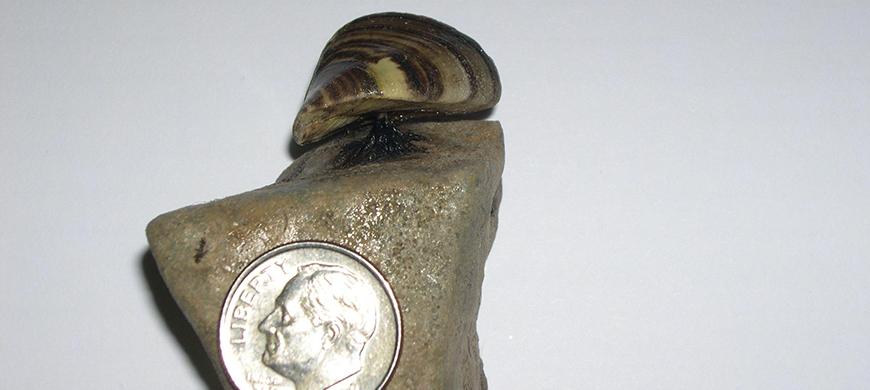Zebra Mussels




Zebra Mussels - Dreissena polymorpha
Where did zebra mussels come from?
- Zebra mussels are native to the Black and Caspian Sea in Europe.
- They arrived into the Great Lakes in 1988 in the ballast water of ships.
Where have zebra mussels been found in Kansas?
- Map of zebra mussel locations in Kansas
- Click here to view the list of Kansas waters with zebra mussels and other aquatic nuisance species.
- Zebra mussels have become widespread throughout the Midwestern US. Click here to see where.
What do zebra mussels look like?
- Zebra mussels look like small clams, usually less than an inch long with a D-shaped shell. Usually the shell is yellowish-brown with alternating dark and light stripes.
- Zebra mussels use sticky byssal threads to attach tightly to any hard surface.
Why are zebra mussels a problem?
- Zebra mussels are a problem because they filter water, up to a liter a day, to eat plankton. Although this filtering action may clear up the water, clear water does NOT mean clean water and the clear water zebra mussels leave behind will often lead to algal blooms that are harmful to people. The clear water can also let UV rays damage fish eggs laid during the spawn.
- Larval fish and native mussels rely on this same plankton to survive.
- Zebra mussels also clog pipes by forming colonies inside of the pipes. Then the water cannot flow through the pipes as easily.
- Nationwide expenditures to control zebra mussels in electric generating plants are estimated at $145 million/year.
How do zebra mussels spread?
- Transport by people is the primary vector for the spread of zebra mussels to unconnected waters.
- Zebra mussels will attach to a solid substrate and can be easily transported on recreational equipment.
- Zebra mussel larvae (veligers) are about the diameter of a human hair and are so small you can't see them without a microscope.
- The veliger floats in a water column for 1-5 weeks and then as it grows it begins to sinks and search for a hard surface on which to live and grow.
- It is illegal to release zebra mussels into a waterbody.
- Zebra mussels are NOT spread by birds.
How do we control zebra mussels?
- Zebra mussels cannot be controlled in the wild.
- Chemicals can be used to kill zebra mussels. If these chemicals were used in an open lake they would also affect fish and native mussels.
- In Virginia, zebra mussels were eradicated from a small lake. Costly, and detrimental to native mussels, this represents the first successful eradication of zebra mussels in the wild and may be used in the future. For more information about this treament visit: http://www.dgif.virginia.gov/zebramussels/
- The spread of zebra mussels can be prevented by draining all of the water from boats, live wells, and bait wells.
- Throughly inspect your boat's hull and trailer for any zebra mussels and remove.
- Wash equipment with 140-degree water (your local car wash hot water rinse),
- Let equipment sit for 5 days.
- Never take fish or plants from one lake and put them in another.
- Never dip your bait bucket into a lake or river if it has water in it from another waterbody.
What do I do if I find zebra mussels?
- If you find a zebra mussel, do not release it back into the water, note the date and location, and call the Emporia Research Office at (620) 342-0658 or email the Aquatic Nuisance Species Coordinator.
- Public assistance in reporting zebra mussel sightings at new locations is essential to help prevent its spread to other inland lakes and rivers.
Images and Recent news
Zebra mussel links:
ANS Education course-Required for Council Grove and Herington City Lake Users
http://nas.er.usgs.gov/zebra.mussel/
http://nas.er.usgs.gov/queries/SpFactSheet.asp?SpeciesID=5
http://www.protectyourwaters.net/hitchhikers/mollusks_zebra_mussel.php









